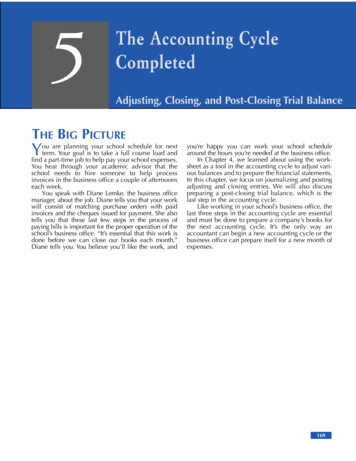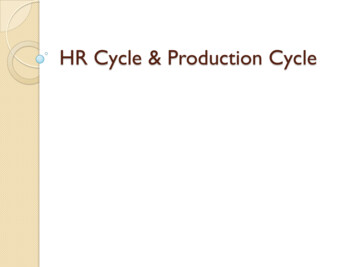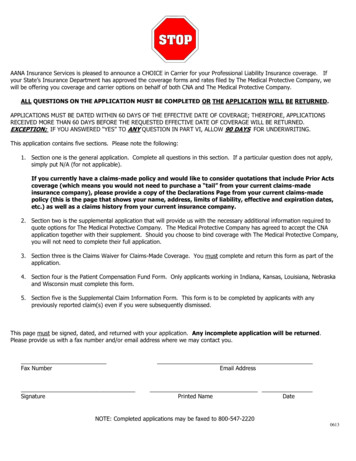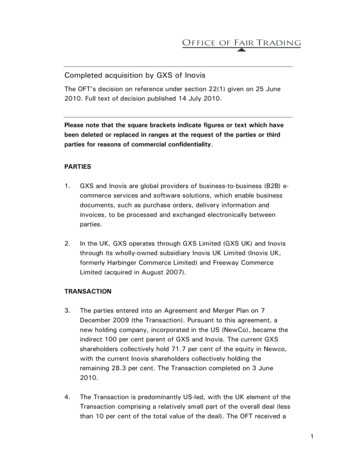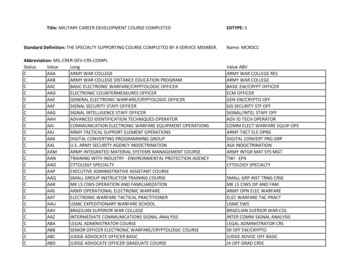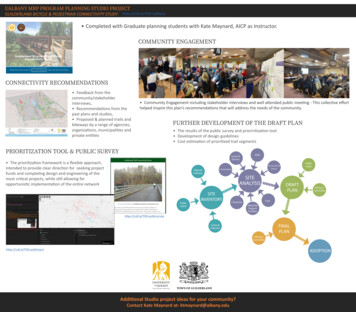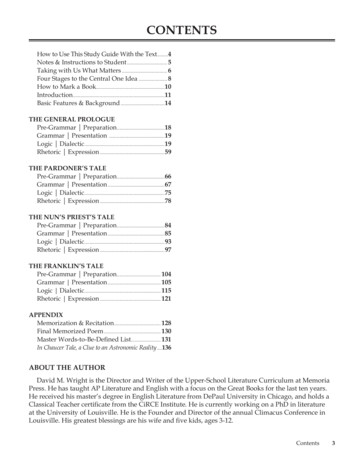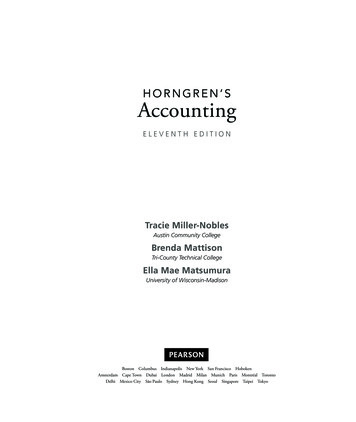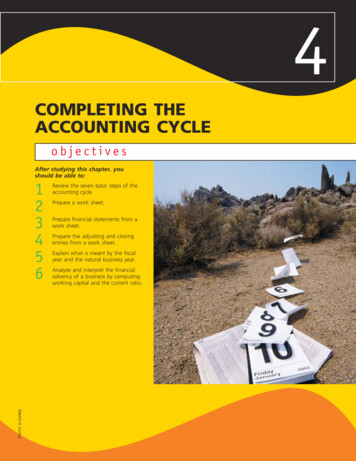
Transcription
5The AccountingCycle CompletedTHE BIG PICTURE Accountants have come a long way from the oldstereotype of “bean counter”—a pale figure witha green eyeshade who tends cloth-bound ledgers andjournals in a back room. In fact, today’s accountantsare more likely to be working from home, perhapsoverlooking the Pacific Ocean while they serve clientsin other provinces via the Internet. At least that’s whatlife is like for Lance and Deanna Gildea, foundersof TAD, an online (or “virtual”) accounting service.TAD accomplishes the entire accounting cycleusing the accounting software of the client’s choice.For the first step of the accounting cycle, which youlearned in Chapter 3, TAD gets clients to scan their invoices, bank statements, and other source documentsinto their computer. TAD even provides the scannerfree of charge to high-end clients. Scanned documents are then transmitted to TAD, and within minutes TAD updates the client’s accounts. One of the bigbenefits of using TAD is that clients get real-time, 24hour access to their accounting data. They simplyuse a Web browser to sign in to their home page(prepared by TAD), where they can view, print, anddownload reports, cheques, and other information.In addition to forming full-service outsourcingoperations like TAD, accountants are morphing intoaccounting software consultants. Harried entrepreneurs or CEOs of small to mid-size companies oftendon’t know how to do more than boot up theirSimply or Peachtree accounting software. They don’thave time to learn how to use it, much less use itcorrectly. Many also can’t afford to pay a full-timeaccountant to do their books. Enter the new accounting software consultant. These accountants are forming different kinds of relationships with clients, evento the extent of teaching them what has historicallybeen the job of the accountant. For instance, BrianPrice of Price and Associates has built a 600,000business by consulting on low-end or small-businessaccounting software. The typical client for a business like Price’s could be anyone from the mom-andpop business bringing in 100,000–200,000 a yearto a 2-million services firm.Whether you end up being an online accountant or an accounting software consultant, you stillneed a thorough grounding in accounting basics.After all, in order to teach your clients how to dotheir books, as Brian Price does, you must be knowledgeable enough to explain each process clearly. Inthis chapter, as you learn how to complete the accounting cycle and close the books, think how youwould explain the process to a client. How will youexplain the process of posting adjusting and closingentries and preparing a post-closing trial balance?Sources: Based on Antoinette Alexander, “Pioneers on thevirtual frontier,” Accounting Technology, Jan/Feb 2000,pp. 18–24; Jeff Stimpson, “The new consultant,” The PracticalAccountant, September 1999, pp. 325–42; AntoinetteAlexander, “The Web: Giving life to a new generation,”Accounting Technology, March 2000, pp. 26–34.ADJUSTING, CLOSING, AND POST-CLOSING TRIAL BALANCE
ChapterObjectives Journalizing and posting adjusting entries (p. 170) Journalizing and posting closing entries (p. 174) Preparing a post-closing trial balance (p. 184)Chapters 3 and 4 we completed these steps of the manual accounting cycle forI nClark’sDesktop Publishing Services:Remember, for ease ofpresentation we are using amonth as the accounting cyclefor Clark’s. In the business world,the cycle can be any time period,but is usually one year.Step 1:Step 2:Step 3:Step 4:Step 5:Step 6:Business transactions occurred and generated source documents.Business transactions were analyzed and recorded in a journal.Information was posted or transferred from journal to ledger.A trial balance was prepared.A worksheet was completed.Financial statements were prepared.This chapter covers the following steps, which will complete Clark’s accountingcycle for the month of May:Step 7: Journalizing and posting adjusting entriesStep 8: Journalizing and posting closing entriesStep 9: Preparing a post-closing trial balanceLEARNING UNIT 5-1Journalizing and Posting Adjusting Entries: Step 7 of the Accounting CycleRECORDING JOURNAL ENTRIES FROM THE WORKSHEETAt this point, many ledgeraccounts are not up to date.Purpose of adjusting entries.170CHAPTER 5The information in the worksheet is up to date. The financial reports prepared fromthat information can give the business’s management and other interested partiesa good idea of where the business stands as of a particular date. The problem isthat the worksheet is an informal report. The information concerning the adjustments has not been placed in the journal, or posted to the ledger accounts. Thismeans that the books are not up to date and ready for the next accounting cycle tobegin. For example, the ledger shows 1,200 of prepaid rent (page 94), but the balance sheet we prepared in Chapter 4 shows an 800 balance. Essentially, the worksheet is a tool for preparing financial reports. Now we must use the adjustmentcolumns of the worksheet as a basis for bringing the ledger up to date. We do thisby adjusting journal entries (see Figure 5-1). Again, the updating must be done before the next accounting period starts. For Clark’s Desktop Publishing Services,the next period begins on June 1.Figure 5-1 shows the adjusting journal entries for Clark’s taken from the adjustments section of the worksheet (see Figure 5-2). Once the adjusting journal entries are posted to the ledger, the accounts making up the financial statements thatwere prepared from the worksheet will correspond with the updated ledger. (Keepin mind that this is the same journal we have been using.) Let’s look at some simplifiedT accounts to show how Clark’s ledger looked before and after the adjustmentswere posted (see adjustments A to D on page 172).
CLARK'S DESKTOP PUBLISHING SERVICESGENERAL JOURNALPage 2PRDr.5141145 0 0 0031 Rent ExpensePrepaid RentRent expired5151154 0 0 0031 Amortization Expense, DTP EquipmentAccumulated Amortization, DTP EquipmentEstimated amortization of asset5161228 0 0031 Office Salaries ExpenseSalaries PayableAccrued salary to May 315112123 5 0 00DateAccount Titles and DescriptionAdjusting EntriesMay 31 Office Supplies ExpenseOffice SuppliesOffice Supplies used upFIGURE 5-1Adjusting Journal EntriesAccount TitlesCashAccounts ReceivableOffice SuppliesPrepaid RentDesktop Publishing EquipmentAccounts PayableBrenda Clark, CapitalBrenda Clark, WithdrawalsDesktop Publishing FeesOffice Salaries ExpenseAdvertising ExpenseTelephone ExpenseFIGURE 5-2Journalizing and PostingAdjustments from theAdjustments Section of theWorksheetOffice Supplies ExpenseRent ExpenseAmortization Expense,DTP EquipmentAccumulated Amortization,DTP EquipmentTrial BalanceDr.Cr.6150612Cr.5 0 0 004 0 0 008 0 003 5 0 00AdjustmentsDr.Cr.5 5 000 0 000 0 000 0 00(A) 5 0 0 00(B) 4 0 0 006 0 0 0 003 3 5 0 0010 0 0 0 006 2 5 008 0 0 0 00(D) 3 5 0 001 3 0 0 002 5 0 002 2 0 002 1 3 5 0 0021 3 5 0 00(A) 5 0 0 00(B) 4 0 0 00(C) 8 0 00(C)Salaries Payable8 0 00(D) 3 5 0 001 3 3 0 001 3 3 0 00THE ACCOUNTING CYCLE COMPLETED171
Adjustments A to D in theadjustments section of theworksheet must be recorded inthe journal and posted to theledger.Adjustment ABefore posting:Office Supplies 114600Office Supplies Expense 514After posting:Office Supplies 114600500Office Supplies Expense 514500Adjustment BBefore posting:Prepaid Rent 1151,200Rent Expense 515After posting:Prepaid Rent 1151,200 400Rent Expense 515400Adjustment CBefore posting:Desktop PublishingEquipment 1216,000AmortizationExpense, DTPEquipment 516AccumulatedAmortization,DTP Equipment 122AmortizationExpense, DTPEquipment 51680AccumulatedAmortization,DTP Equipment 12280After posting:Desktop PublishingEquipment 1216,000This last adjustment shows the same balances for Amortization Expense andAccumulated Amortization. However, in subsequent adjustments the AccumulatedAmortization balance will keep getting larger, but the debit to Amortization Expenseand the credit to Accumulated Amortization will be the same. We will see why in amoment.Adjustment D172CHAPTER 5Before posting:Office SalariesExpense 511650650SalariesPayable 212After posting:Office SalariesExpense 511650650350SalariesPayable 212350
LEARNING UNIT 5-1 REVIEWAT THIS POINT you should be able to: Define and state the purpose of adjusting entries. (p. 170) Journalize adjusting entries from the worksheet. (p. 171) Post journalized adjusting entries to the ledger. (p. 172) Compare specific ledger accounts before and after posting of the journalizedadjusting entries. (p. 172)SELF-REVIEW QUIZ 5-1( The blank forms you need are on pages 5-1 and 5-2 of the Study Guide withWorking Papers.)Turn to the worksheet of P. Logan Company (p. 140) and (1) journalize and postthe adjusting entries and (2) compare the adjusted ledger accounts before and afterthe adjustments are posted. T accounts with beginning balances are provided inyour Study Guide.Solution to Self-Review Quiz 5-1Quiz TipThese journal entries come fromthe adjustments column of theworksheet.Page 2PRAccount Titles and DescriptionAdjusting EntriesDec. 31 Amortization Expense, Store Equipment511Accumulated Amortization, Store Equipment 122Estimated amortization of equipmentDateDr.Cr.1 001 0031 Insurance ExpensePrepaid InsuranceInsurance expired5161162 0031 Supplies ExpenseStore SuppliesStore Supplies used5141144 0031 Salaries ExpenseSalaries PayableAccrued salaries payable5122123 002 004 00THE ACCOUNTING CYCLE COMPLETED3 00173
PARTIAL LEDGERBefore PostingAfter tedExpense,Amortization,Expense,Amortization,Store Equipment 511Store Equipment 122Store Equipment 511Store Equipment 1224141Prepaid Insurance 1163Insurance Expense 516Prepaid Insurance 1163 2Insurance Expense 5162Store Supplies 1145Supplies Expense 514Store Supplies 1145 4Supplies Expense 5144Salaries Expense 5128Salaries Payable 212Salaries Expense 51283Salaries Payable 2123LEARNING UNIT 5-2Journalizing and Posting Closing Entries: Step 8 of the Accounting CycleTo make recording of the next fiscal year’s transactions easier, a mechanical step,called closing, is taken by the accountant at Clark’s. Closing is used to end — orclose off—the revenue, expense, and withdrawal accounts at the end of the fiscal year.The information needed to complete closing entries will be found in the incomestatement and balance sheet sections of the worksheet.To make it easier to understand this process, we will first look at the differencebetween temporary (nominal) accounts and permanent (real) accounts.Here is the expanded accounting equation we used in an earlier chapter:Assets Liabilities Capital Withdrawals Revenues ExpensesPermanent accounts are foundon the balance sheet.Three of the items in that equation — assets, liabilities, and capital — are knownas real or permanent accounts, because their balances are carried over from onefiscal year to another. The other three items — withdrawals, revenue, and expenses —are called nominal or temporary accounts, because their balances are not carried overfrom one fiscal year to another. Instead, their balances are set at zero at the beginning of each fiscal year. This allows us to accumulate new data about revenue, expenses, and withdrawals in the new fiscal year. The process of closing summarizesthe effects of the temporary accounts on capital for that period by using closingjournal entries and by posting them to the ledger. When the closing process is complete, the accounting equation will be reduced to:Assets Liabilities Ending CapitalAfter all closing entries arejournalized and posted to theledger, all temporary accountshave a zero balance in the ledger.Closing is a step-by-step process.174CHAPTER 5If you look back at page 142 in Chapter 4, you will see that we have calculatedthe new capital on the balance sheet for Clark’s Desktop Publishing Services to be 14,275. But before the mechanical closing procedures are journalized and posted,the capital account of Brenda Clark in the ledger is only 10,000 (Chapter 3, page 94).Let’s look now at how to journalize and post closing entries.
HOW TO JOURNALIZE CLOSING ENTRIESThere are four steps to be performed in journalizing closing entries:An Income Summary is atemporary account located in thechart of accounts under Owner’sEquity. It does not have a normalbalance of a debit or a credit.Sometimes, closing the accountsis referred to as “clearing theaccounts.”Step 1: Clear the revenue balances and transfer them to Income Summary. IncomeSummary is a temporary account in the ledger needed for closing. At theend of the closing process there will be no balance in Income Summary.Revenue Income SummaryStep 2: Clear the individual expense balances and transfer them to Income Summary.Expenses Income SummaryStep 3: Clear the balance in Income Summary and transfer it to Capital.Income Summary CapitalStep 4: Clear the balance in Withdrawals and transfer it to Capital.Withdrawals CapitalDon’t forget two goals of closing:1. Clear all temporary accountsin the ledger.2. Update Capital to a newbalance that reflects asummary of all the temporaryaccounts.All numbers used in the closingprocess can be found on theworksheet in Figure 5-4 (page176). Note that the accountIncome Summary is not on theworksheet.Figure 5-3 is a visual representation of these four steps. Keep in mind that thisinformation must first be journalized and then posted to the appropriate ledgeraccounts. The worksheet presented in Figure 5-4 contains all the figures we willneed for the closing process.Step 1: Clear Revenue Balances and Transfer to Income SummaryHere is what is in the ledger before closing entries are journalized and posted:Desktop Publishing Fees 4118,000Income Summary 313The income statement section on the worksheet on page 176 shows that the DesktopPublishing Fees have a credit balance of 8,000. To close or clear this to zer
of TAD, an online (or “virtual”) accounting service. TAD accomplishes the entire accounting cycle using the accounting software of the client’s choice. For the first step of the accounting cycle, which you learned in Chapter 3, TAD gets clients to scan their in-voices, bank statements, and other source documents into their computer. TAD even provides the scannerFile Size: 2MBPage Count: 63Explore furtherAccounting Cycle - Steps in Accounting Cycle with Exampleswww.tutorialkart.comAccounting Cycle - Steps Flow Chart Example How to .www.myaccountingcourse.comAccounting Cycle Exercises III - Kenyatta Universitylibrary.ku.ac.keAccounting cycle - explanation, steps, example .www.accountingformanagement.orgAccounting Cycle Definition, Steps & Examplexplaind.comRecommended to you based on what's popular Feedback
